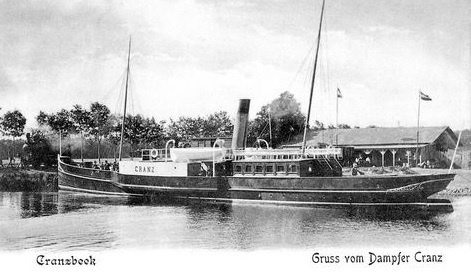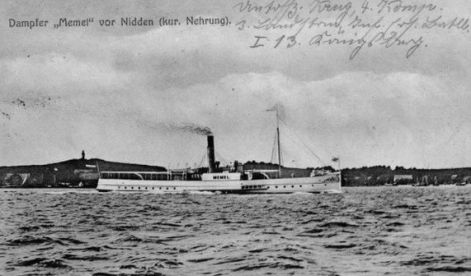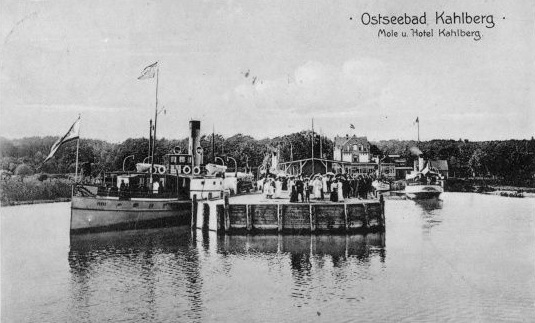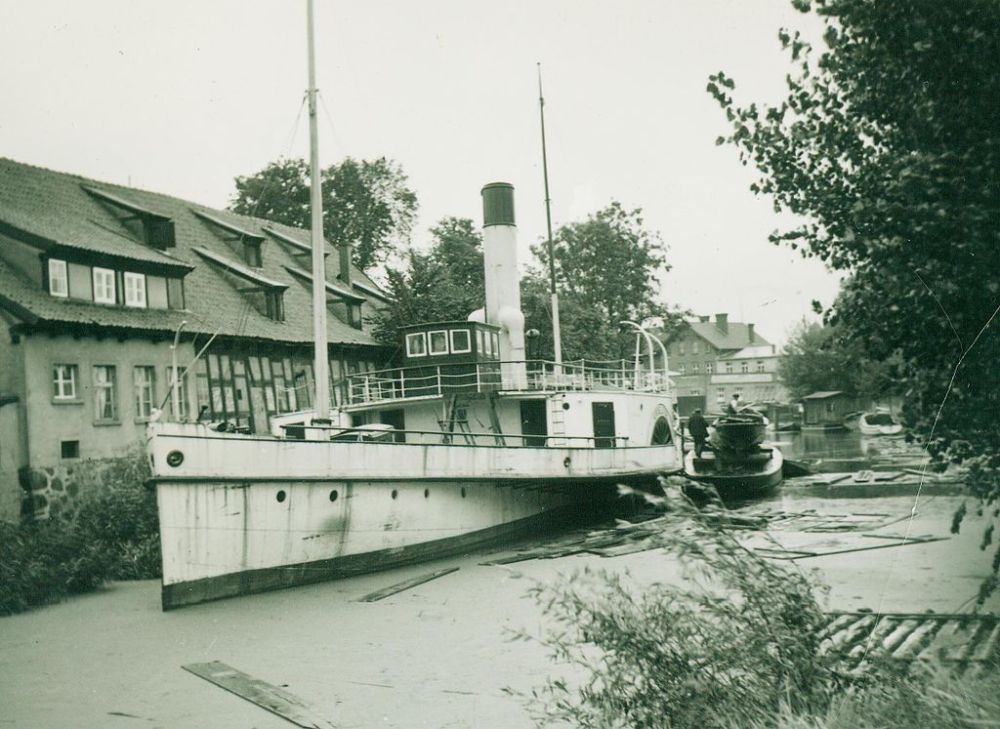paddlesteamers.info : The Internet's leading website for
Side-Wheeled Paddle Steamers
Germany : East Prussia and Danzig
River Memel (now Neman), Curonian Lagoon and Memel (now Klaipeda)
The
River Memel was usually regarded as the edge of Imperial Germany
and of East Prussia. It formed the border with the Russian Empire. To
the north was the port of Memel and an area of land (Memelland) which
was incorporated into Germany. After the Treaty of Versailles
concluding the First World War, Memelland was put under French control
pending a settlement of its status with Germany and newly-independent
Lithuania laying claim. The area was occupied by Lithuania in 1923
which complicated arrangements on the River and for services to the
city of Memel which were only resolved when, under pressure, the area
was given back to Nazi Germany in March 1939. After the war, the area
was incorporated into the Soviet Republic of Lithuania and East Prussia
itself split between Soviet Russia and Poland.
The Curonia lagoon is protected from the main Baltic Sea behind a large sand bar (the Curonian
Spit) a is now national park with a small number of small settlements.
A steamer service linked the resorts of the lagoon-side of the spit
with the city of Memel (now Klaipeda, Lithuania) in the north and Cranz
(now Zelenogradsk, Russia) in the south,
There
was a healthy paddle steamer excursion trade on the Memel river based at the
local capital Tilsit, now called Sovetsk in Russia's Kaliningrad
Oblast.
The
mass evacuation of German citizens in the face of advancing Soviet
troops in 1944 brought an immediate end to German life and the river
excursion business which had survived during wartime. Paddle Steamer Grenzland,
appropriately renamed after arriving in 1933 in Germany's Border Land
was one of the vessels involved in the evacuation, sailing fully loaded
to Copenhagen
Cranz-Memel Line : Memel-Cranzer Dampfschiffsgesellschaft
The
Cranz-Memel Line service linked the small resort villages on
the Curonian Spit, serving Memel (now Klaipeda LT) , Schwarzort, Preil, Nidden, Rossiten
and Cranz (now Zelenogradsk, RU), with a timed railway connection to Koenigsberg at Cranzbeek
which was just a short distance from Cranz itself, the resort on the
Baltic Coast.
In
1913 the paddlers Memel and Cranz were on the route operated daily with
one return sailing each (PS Cranz from Memel, May 1 - Sept 30 and PS
Memel from Cranz May 8 - August 31, a journey of approximately six
hours in each direction). Following the withdrawal of the paddle steamers the service was in the hands of new screw steamers
Cranz (1885-1920) Bought new from builders in Kiel

Above : Post card view of Cranz moored at Cranzbeek
Memel (1910 - 1920*) Originally in London as King Alfred. Possibly sold to B Bieber for use at Memel from 1921. From 1924 she sailed out of Hamburg

Above : Post Card View of Memel
Reederei Gebruder Berger, based in Russ, now Rusne LT.
Beethoven (originally in London as Gresham).
Operated from 1920 until she was sold for use in Prague in 1926.
Herold (Originally in London ?)
Russ
Zellstoff Fabrik of Tilsit (Cellulose Factory)
Gustel (Former tug. ZW on the funnel)
Reederei Wilhelm Skorloff
Grenzland (1933-1945)
Formerly Freya on ferry run from the North Frisian island of Sylt to the mainland at Hoyer. Based at Tilsit. Particularly associated with music cruises and
charters including school trips which continued until 1944 until the
ship was used to transport wounded citizens and finally evacuees to
Memel before her own final flight. Not in a regular timetabled service.
Fleetmate was MV Herbert with Captain Skorloff in command.
Tilsiter Dampfer Verein
Konigin Luise (1919-1925)
Built in 1911 by Werft Fechter at Koenigsberg (now Kaliningrad)
Length 42.6 m
Built for the Tilsiter Dampfer Verein for service on the River Memel as Konigin Luise
Bought in 1925 by the Hamburg-Blankensese-Este Line and brought to Hamburg
Renamed Lessing in 1929
Taken over by HADAG in 1963 and scrapped in 1964
TBA
Rapid called at Turner-Bad. Still in service in 1929
Condor
Cito
Trapponen
Falke
Wischwill
Waltraut
Schnell
Turner (?) (sailed from Turner-Bad to Schlossberg) There is reference to a motor ship Turner
Note
: A postcard image (post 1920) shows two almost identical paddlers tied
up together at Tilsit. Look to be ex-LCC but not Beethoven (or Memel).
One is probably Herold
19th Century
Luna - built in 1837 by J&W Napier of Glasgow. Registered at Memel from 1846
Terra - built 1856 by Scott & Co of Greenock. Traded on the river Memel but registered to a Mr William Taylor of Greenock
Terra
Nova - built in 1859 by Denny of Dumbarton for Clyde service
as Lochlong. From 1868 at Memel as Terra Nova until moved to Russia in
1880
Tilsit-based shipping companies : Preugschat, Schienther, Meyhofer (based in Konigsberg)
Benno Bieber : Bieber
established a shipping company in Memel in 1912 and served the lagoon
resorts with his steamer Schwarzort. After World War I his company
operated tugs and arranged charters. The business passed to his sons,
the Heinz and Helmut
City of Elbing (now Elblag, Poland) and the Vistula Lagoon
Shipping
services in Elbing made an inauspicious start after Jacob Riesen, head
of the Elbing City council, along with a number of other notables of
the city established a shipping company in 1828 to link the city with
Koenigsberg with the locally built paddle steamer Copernikus. The ship
was wrecked less than two months after the service opened.
More successful paddle steamer services began in 1841 with the
arrival of the steamers Schwalbe and Falke, built by Ditchburn &
Mare of Poplar, London. A consortium of businessmen established a link
with the fishing village of Kahlberg (now Krynica Morska) which
straddled the spit between the Baltic Sea and the Vistula lagoon
turning it into a popular tourist resort. The paddler Adler was added
later.
It was not
until the 1850s that Riesen could claim a successful passenger service.
The paddle steamers Julius Born (sternwheeler) and Linau established a
regular link between Elbing and Danzig. These were built by the
Schichau yard in Elbing which grew to be a major builder of sea-going
vessels, primarily screw steamers.
Schichau was a successful
shipbuilder. In 1896 they built the 68 m long paddler Badenia IX for
service at Mannheim. Later renamed Mainz it was bombed and sunk in 1945
but raised and the wreck later rebuilt as a Voith-Schneider-propelled
motor vessel Westmark which survived until burnt out in 1978.
Schichau
also got involved in shipping as a shareholder in a local company and
expanded his interests and after takeovers, the Elbinger Dampfschiffs
Rhederei F Schichau was formed in 1887.
Whilst August
Zedler's company established predominance on the lagoon service to the
resort of Kahlberg, competition was not far away with Schichau
establishing a steamship company in Kahlberg 1908 with the screw steam
ships Moewe and Tolkemit capitalising on newly-built pier facilities
which ended the need for passengers to be rowed or carried ashore.
August Zedler (Reederei fuer Fluss- und Haffschiffahrt
Schiffsexpedition)
August Zedler formed a shipping company in 1881 with the Maria and
added a stern-wheeler, Anna, in 1889 to increase services from Elbing
to Kahlberg (now Krynica Morska). Elsa was added in 1896 followed later by and the screw
steamers Kahlberg and Sophia, the paddler Flora
(which was later
converted to screw propulsion) and in 1911 the screw-driven
Preussen. Zedler died in 1917 and the company was bought by Emil
Berger whose operations were based in Russ. The old paddle steamer Anneliese (ex- Frisia) was purchased in 1931 and was in service until 1937. Further details are unclear
but she was reportedly sold to Captain Wilhelm Skorloff (who owned
Grenzland) in 1943 and was renamed Ostland but did not enter service and did
not escape the advance of Soviet forces in 1944

Above : A post card view of the steamer pier at Kahlberg with paddle steamer Flora

Above : Anneliese seen laid up and out of service at Koenigsberg (now Kaliningrad, Russia) in 1938.
Original Photographer : Dr Julius Christiansen (1897-1951)
Source : Wiki Commons published under Creative Commons licence https://creativecommons.org/licenses/by-sa/3.0/deed.en
Danzig (now Gdansk, Poland)
The
first steamship to come to Danzig was the English-built Xsiaze
Xawery of 1827 which sailed to the nearby coastal resort of Sopot.
Various attempts were made to offer cruises in the following year but
nothing was formalised until 1841 when cruises were undertaken along
the Vistula from the city of Danzig to Nowy Port at the mouth of
the river with the vessel Der Pfeil. Its success led to the
introduction of Der Blitz to strengthen the service offered.
The
Weichsel Danziger Dampfschiffahrt und Seebad AG became the
dominant operator and a leading force in local tourism. In
1905 a large new paddle steamer was ordered to take passengers to the
resorts which the company had developed along the extensive sandy
coastline near Danzig. The vessel was the Paul Beneke, built by the local JW Klawitter yard
In
March 1945 the ship was used for the evacuation of German residents
from areas coming under Soviet attack, and, unable to return, Paul
Beneke was re-registed at the port of Lubeck out of which she served
until withdrawn and scrapped at Hamburg in 1951
Paul Beneke : Length 44.0 m. Engine : Three cylinder
Return to
Historical
Database



